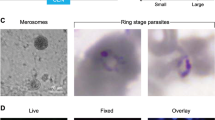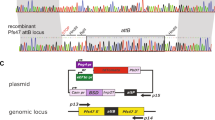Abstract
This protocol describes a methodology for imaging the sequestration of infected erythrocytes of the rodent malaria parasite Plasmodium berghei in the bodies of live mice or in dissected organs, using a transgenic parasite that expresses luciferase. Real-time imaging of infected erythrocytes is performed by measuring bioluminescence produced by the enzymatic reaction between luciferase and its substrate luciferin, which is injected into the mice several minutes prior to imaging. The bioluminescence signal is detected by an intensified charge-coupled device (I-CCD) photon-counting video camera. Sequestration of infected erythrocytes is imaged during short-term infections with synchronous parasite development or during ongoing infections. With this technology, sequestration patterns of the schizont stage can be quantitatively analyzed within 1–2 d after infection. Real-time in vivo imaging of infected erythrocytes will provide increased insights into the dynamics of sequestration and its role in pathology, and can be used to evaluate strategies that prevent sequestration.
This is a preview of subscription content, access via your institution
Access options
Subscribe to this journal
Receive 12 print issues and online access
$259.00 per year
only $21.58 per issue
Buy this article
- Purchase on Springer Link
- Instant access to full article PDF
Prices may be subject to local taxes which are calculated during checkout





Similar content being viewed by others
References
Amino, R., Menard, R. & Frischknecht, F. In vivo imaging of malaria parasites — recent advances and future directions. Curr. Opin. Microbiol. 8, 407–414 (2005).
Heussler, V. & Doerig, C. In vivo imaging enters parasitology. Trends Parasitol. 22, 192–195 (2006).
Franke-Fayard, B. et al. Murine malaria parasite sequestration: CD36 is the major receptor, but cerebral pathology is unlinked to sequestration. Proc. Natl. Acad. Sci. USA 102, 11468–11473 (2005).
Ho, M. & White, N.J. Molecular mechanisms of cytoadherence in malaria. Am. J. Physiol. 276, C1231–C1242 (1999).
Sherman, I.W., Eda, S. & Winograd, E. Cytoadherence and sequestration in Plasmodium falciparum: defining the ties that bind. Microbes Infect. 5, 897–909 (2003).
Mackintosh, C.L., Beeson, J.G. & Marsh, K. Clinical features and pathogenesis of severe malaria. Trends Parasitol. 20, 597–603 (2004).
Hunt, N.H. & Grau, G.E. Cytokines: accelerators and brakes in the pathogenesis of cerebral malaria. Trends Immunol. 24, 491–499 (2003).
Janse, C.J. & Waters, A.P. Plasmodium berghei: the application of cultivation and purification techniques to molecular studies of malaria parasites. Parasitol. Today 11, 138–143 (1995).
Janse, C., Ramesar, J. & Waters, A.P. High efficiency transfection and drug-selection of genetically transformed blood stages of the rodent malaria parasite, P. berghei. Nat. Protocols (2006) (doi:10.1038/nprot.2006.53).
Kirchgatter, K. & Del Portillo, H.A. Clinical and molecular aspects of severe malaria. An. Acad. Bras. Cienc. 77, 455–475 (2005).
Cowman, A.F. & Crabb, B.S. Invasion of red blood cells by malaria parasites. Cell 124, 755–766 (2006).
Gilks, C.F., Jarra, W., Harvey-Wood, K., McLean, S.A. & Schetters, T. Host diet in experimental rodent malaria: a variable which can compromise experimental design and interpretation. Parasitology 98, 175–177 (1989).
Ho, M., Hickey, M.J., Murray, A.G., Andonegui, G. & Kubes, P. Visualization of Plasmodium falciparum–endothelium interactions in human microvasculature: mimicry of leukocyte recruitment. J. Exp. Med. 192, 1205–1211 (2000).
Sadikot, R.T. & Blackwell, T.S. Bioluminescence imaging. Proc. Am. Thorac. Soc. 2, 537–532 (2005).
Welsh, D.K. & Kay, S.A. Bioluminescence imaging in living organisms. Curr. Opin. Biotechnol. 16, 73–78 (2005).
Ntziachristos, V., Ripoll, J., Wang, L.V. & Weissleder, R. Looking and listening to light: the evolution of whole-body photonic imaging. Nat. Biotechnol. 23, 313–320 (2005).
Dufresne, A.T. & Gromeier, M. A nonpolio enterovirus with respiratory tropism causes poliomyelitis in intercellular adhesion molecule 1 transgenic mice. Proc. Natl. Acad. Sci. USA 101, 13636–13641 (2004).
Helmchen, F. & Denk, W. Deep tissue two-photon microscopy. Nat. Methods 2, 932–940 (2005).
Dunn, K.W. & Young, P.A. Principles of multiphoton microscopy. Nephron Exp. Nephrol. 103, e33–e40 (2006).
de Souza, J.B. & Riley, E.M. Cerebral malaria: the contribution of studies in animal models to our understanding of immunopathogenesis. Microbes Infect. 4, 291–300 (2002).
Acknowledgements
We would like to thank H. Kroeze, J. Ramesar and S. Khan for their critical comments.
Author information
Authors and Affiliations
Corresponding author
Ethics declarations
Competing interests
The authors declare no competing financial interests.
Rights and permissions
About this article
Cite this article
Franke-Fayard, B., Waters, A. & Janse, C. Real-time in vivo imaging of transgenic bioluminescent blood stages of rodent malaria parasites in mice. Nat Protoc 1, 476–485 (2006). https://doi.org/10.1038/nprot.2006.69
Published:
Issue Date:
DOI: https://doi.org/10.1038/nprot.2006.69
This article is cited by
-
A retinal model of cerebral malaria
Scientific Reports (2019)
-
An ultrasensitive NanoLuc-based luminescence system for monitoring Plasmodium berghei throughout its life cycle
Malaria Journal (2016)
-
Plasmodium berghei bio-burden correlates with parasite lactate dehydrogenase: application to murine Plasmodium diagnostics
Malaria Journal (2016)
-
Advances in molecular genetic systems in malaria
Nature Reviews Microbiology (2015)
Comments
By submitting a comment you agree to abide by our Terms and Community Guidelines. If you find something abusive or that does not comply with our terms or guidelines please flag it as inappropriate.



